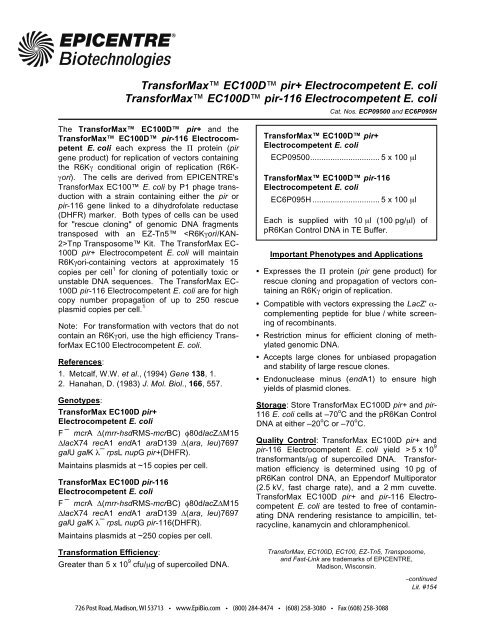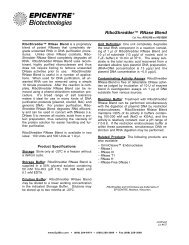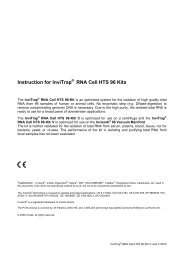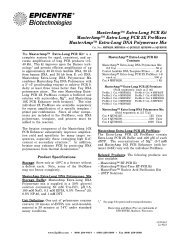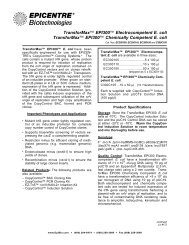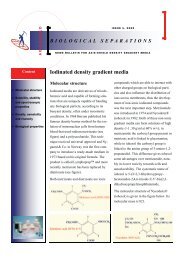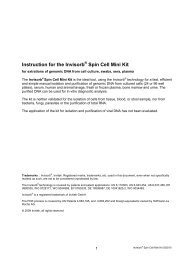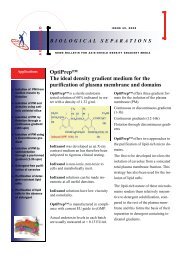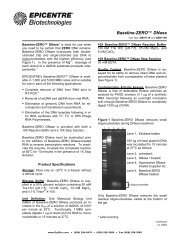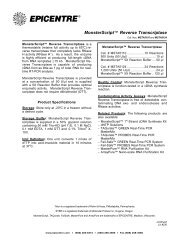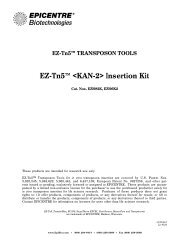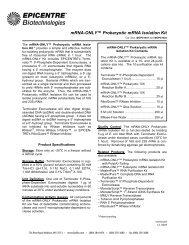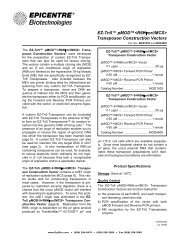Protocol for TransforMax™ EC100D™ pir+ Electrocompetent E. coli ...
Protocol for TransforMax™ EC100D™ pir+ Electrocompetent E. coli ...
Protocol for TransforMax™ EC100D™ pir+ Electrocompetent E. coli ...
Create successful ePaper yourself
Turn your PDF publications into a flip-book with our unique Google optimized e-Paper software.
Trans<strong>for</strong>Max EC100D <strong>pir+</strong> <strong>Electrocompetent</strong> E. <strong>coli</strong><br />
Trans<strong>for</strong>Max EC100D pir-116 <strong>Electrocompetent</strong> E. <strong>coli</strong><br />
Cat. Nos. ECP09500 and EC6P095H<br />
The Trans<strong>for</strong>Max EC100D <strong>pir+</strong> and the<br />
Trans<strong>for</strong>Max EC100D pir-116 <strong>Electrocompetent</strong><br />
E. <strong>coli</strong> each express the protein (pir<br />
gene product) <strong>for</strong> replication of vectors containing<br />
the R6K conditional origin of replication (R6Kori).<br />
The cells are derived from EPICENTRE's<br />
Trans<strong>for</strong>Max EC100 E. <strong>coli</strong> by P1 phage transduction<br />
with a strain containing either the pir or<br />
pir-116 gene linked to a dihydrofolate reductase<br />
(DHFR) marker. Both types of cells can be used<br />
<strong>for</strong> "rescue cloning" of genomic DNA fragments<br />
transposed with an EZ-Tn5 Tnp Transposome Kit. The Trans<strong>for</strong>Max EC-<br />
100D <strong>pir+</strong> <strong>Electrocompetent</strong> E. <strong>coli</strong> will maintain<br />
R6K ori-containing vectors at approximately 15<br />
copies per cell 1 <strong>for</strong> cloning of potentially toxic or<br />
unstable DNA sequences. The Trans<strong>for</strong>Max EC-<br />
100D pir-116 <strong>Electrocompetent</strong> E. <strong>coli</strong> are <strong>for</strong> high<br />
copy number propagation of up to 250 rescue<br />
plasmid copies per cell. 1<br />
Note: For trans<strong>for</strong>mation with vectors that do not<br />
contain an R6K ori, use the high efficiency Trans<strong>for</strong>Max<br />
EC100 <strong>Electrocompetent</strong> E. <strong>coli</strong>.<br />
References:<br />
1. Metcalf, W.W. et al., (1994) Gene 138, 1.<br />
2. Hanahan, D. (1983) J. Mol. Biol., 166, 557.<br />
Genotypes:<br />
Trans<strong>for</strong>Max EC100D <strong>pir+</strong><br />
<strong>Electrocompetent</strong> E. <strong>coli</strong><br />
F mcrA (mrr-hsdRMS-mcrBC) 80dlacZ M15<br />
lacX74 recA1 endA1 araD139 (ara, leu)7697<br />
galU galK rpsL nupG <strong>pir+</strong>(DHFR).<br />
Maintains plasmids at ~15 copies per cell.<br />
Trans<strong>for</strong>Max EC100D pir-116<br />
<strong>Electrocompetent</strong> E. <strong>coli</strong><br />
F mcrA (mrr-hsdRMS-mcrBC) 80dlacZ M15<br />
lacX74 recA1 endA1 araD139 (ara, leu)7697<br />
galU galK rpsL nupG pir-116(DHFR).<br />
Maintains plasmids at ~250 copies per cell.<br />
Trans<strong>for</strong>mation Efficiency:<br />
Greater than 5 x 10 9 cfu/μg of supercoiled DNA.<br />
Trans<strong>for</strong>Max EC100D <strong>pir+</strong><br />
<strong>Electrocompetent</strong> E. <strong>coli</strong><br />
ECP09500............................... 5 x 100 μl<br />
Trans<strong>for</strong>Max EC100D pir-116<br />
<strong>Electrocompetent</strong> E. <strong>coli</strong><br />
EC6P095H .............................. 5 x 100 μl<br />
Each is supplied with 10 μl (100 pg/μl) of<br />
pR6Kan Control DNA in TE Buffer.<br />
Important Phenotypes and Applications<br />
• Expresses the protein (pir gene product) <strong>for</strong><br />
rescue cloning and propagation of vectors containing<br />
an R6K origin of replication.<br />
• Compatible with vectors expressing the LacZ' -<br />
complementing peptide <strong>for</strong> blue / white screening<br />
of recombinants.<br />
• Restriction minus <strong>for</strong> efficient cloning of methylated<br />
genomic DNA.<br />
• Accepts large clones <strong>for</strong> unbiased propagation<br />
and stability of large rescue clones.<br />
• Endonuclease minus (endA1) to ensure high<br />
yields of plasmid clones.<br />
Storage: Store Trans<strong>for</strong>Max EC100D <strong>pir+</strong> and pir-<br />
116 E. <strong>coli</strong> cells at –70 o C and the pR6Kan Control<br />
DNA at either –20 o C or –70 o C.<br />
Quality Control: Trans<strong>for</strong>Max EC100D <strong>pir+</strong> and<br />
pir-116 <strong>Electrocompetent</strong> E. <strong>coli</strong> yield > 5 x 10 9<br />
trans<strong>for</strong>mants/μg of supercoiled DNA. Trans<strong>for</strong>mation<br />
efficiency is determined using 10 pg of<br />
pR6Kan control DNA, an Eppendorf Multiporator<br />
(2.5 kV, fast charge rate), and a 2 mm cuvette.<br />
Trans<strong>for</strong>Max EC100D <strong>pir+</strong> and pir-116 <strong>Electrocompetent</strong><br />
E. <strong>coli</strong> are tested to free of contaminating<br />
DNA rendering resistance to ampicillin, tetracycline,<br />
kanamycin and chloramphenicol.<br />
Trans<strong>for</strong>Max, EC100D, EC100, EZ-Tn5, Transposome,<br />
and Fast-Link are trademarks of EPICENTRE,<br />
Madison, Wisconsin.<br />
continued<br />
Lit. #154<br />
726 Post Road, Madison, WI 53713 • www.EpiBio.com • (800) 284-8474 • (608) 258-3080 • Fax (608) 258-3088
EPICENTRE Trans<strong>for</strong>Max EC100D <strong>pir+</strong> <strong>Electrocompetent</strong> E. <strong>coli</strong><br />
Trans<strong>for</strong>Max EC100D pir-116 <strong>Electrocompetent</strong> E. <strong>coli</strong><br />
Electroporation Procedure<br />
Note: The electroporation procedure described here uses 50 µl of electrocompetent cells. A different<br />
volume of cells can also be used based on the experiences and needs of the user. It is critical that the<br />
DNA, cuvettes, electroporation chamber (if applicable), and microcentrifuge tubes are thoroughly chilled<br />
on ice.<br />
Caution: DNA should be prepared in water or very low ionic strength buffer (e.g., TE Buffer: 10 mM Tris-<br />
HCl [pH 7.5], 1 mM EDTA) to prevent arcing during electroporation. DNA from an EPICENTRE Fast-Link<br />
DNA ligation reaction can be diluted and used directly, without desalting or ethanol precipitation.<br />
1. Thaw Trans<strong>for</strong>Max EC100D <strong>pir+</strong> or pir-116 cells on ice. Mix gently. Use the cells immediately.<br />
Unused cells can be refrozen at –70 o C. Note: Refrozen cells may have reduced trans<strong>for</strong>mation efficiency,<br />
but <strong>for</strong> most cases, the reduction is not significant enough to interfere with the desired<br />
results.<br />
2. Transfer the desired amount of DNA and 50 µl of cells to a pre-chilled microcentrifuge tube. Note: a<br />
smaller volume of cells can be used based on the needs and experiences of the user. Mix the cells<br />
and DNA by pipetting up and down 2-3 times.<br />
Control (Optional): Dilute the pR6Kan control DNA 1:10 with sterile, distilled water. Add 1 µl (10 pg)<br />
to 50 µl of cells as described.<br />
3. Transfer the cell/DNA mix to the electroporation cuvette. Be sure that there are no air bubbles in the<br />
cuvette. Wipe the cuvette of any condensation. Place into the electroporator and apply the electric<br />
pulse at the manufacturer's recommendations <strong>for</strong> bacterial (E. <strong>coli</strong>) electroporation.<br />
4. Immediately after electroporation, add 950 µl of the room temperature SOC medium 2 to the cuvette.<br />
Mix gently by pipetting up and down 2-3 times.<br />
5. Transfer the cells to a sterile culture tube and incubate at 37 o C with shaking at 220-230 rpm <strong>for</strong> 1<br />
hour to recover the cells and allow expression of the antibiotic resistance marker.<br />
6. We recommend diluting the cells 1:10 and 1:100 and plating 100 µl of each dilution to the appropriate<br />
medium and antibiotic plate. Incubate the plates at 37 o C overnight.<br />
Control (Optional): Dilute the control reaction 1:20 and plate 100 µl (equivalent to 0.05 pg DNA) to<br />
LB-kanamycin (50 µg/ml) plates. If 250 colonies are observed on the plate, the trans<strong>for</strong>mation efficiency<br />
is 5 x 10 9 cfu/ µg or [(250 cfu/0.05 pg DNA) x (10 6 pg/µg)].<br />
Related Products: The following products are also available:<br />
– EZ-Tn5 Tnp Transposome Kit<br />
– EZ-Tn5 Transposon<br />
– Trans<strong>for</strong>Max EC100 <strong>Electrocompetent</strong> E. <strong>coli</strong><br />
– Fast-Link DNA Ligation Kits<br />
page 2 1/10


